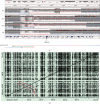A Palindrome-Like Structure on 16p13.3 Is Associated with the Formation of Complex Structural Variations and SRRM2 Haploinsufficiency
- PMID: 40225164
- PMCID: PMC11918891
- DOI: 10.1155/2023/6633248
A Palindrome-Like Structure on 16p13.3 Is Associated with the Formation of Complex Structural Variations and SRRM2 Haploinsufficiency
Abstract
SRRM2 encodes a splicing factor recently implicated in developmental disorders due to a statistical enrichment of de novo mutations. Using data from the 100,000 Genomes Project, four unrelated individuals with intellectual disability (ID) were identified, each harbouring de novo whole gene deletions of SRRM2. Deletions ranged between 248 and 482 kb in size and all distal breakpoints clustered within a complex 144 kb palindrome situated 75 kb upstream of SRRM2. Strikingly, three of the deletions were complex, with inverted internal segments of 45-94 kb. In one proband-mother duo, de novo status was inferred by haplotype analysis. Together with two additional patients who harboured smaller predicted protein-truncating variants (p.Arg632∗ and p.Ala2223Leufs∗13), we estimate the prevalence of this condition in cohorts of patients with unexplained ID to be ~1/1300. Phenotypic blending, present for two cases with additional pathogenic variants in CASR/PKD1 and SLC17A5, hampered the phenotypic delineation of this recently described condition. Our data highlights the benefits of genome sequencing for resolving structural complexity and inferring de novo status. The genomic architecture of 16p13.3 may give rise to relatively high rates of complex rearrangements, adding to the list of loci associated with recurrent genomic disorders.
Copyright © 2023 Alistair T. Pagnamenta et al.
Conflict of interest statement
The authors have no conflicting interests to declare.
Figures



References
Publication types
MeSH terms
Substances
Associated data
LinkOut - more resources
Full Text Sources
Miscellaneous

